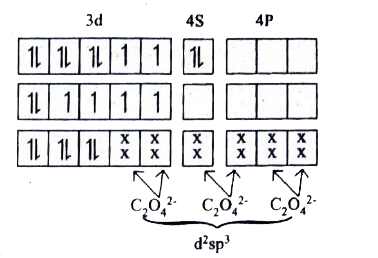On the basis of VB theory explain the nature of bonding in .
In the complex entity , the is in oxidation state . The outer electronic configuration of is . The oxalato ligand is fairly strong field ligand. So it faces the electrons in to pair up and make two of the orbitals available for bonding. As a result, shows hybridisation.
Electronic configuration of atom
Electronic configuration of ion
Hybridisation and formation of
There is no unpaired electron in . Thus is diamagnetic in nature.
During the formation of , two of the -orbitals are used in bonding. Therefore it is an inner orbital (low spin)complex.
The has the octahedral geometry.

Topper's Solved these Questions
- COORDINATION CHEMISTRYBook:FULL MARKSChapter:COORDINATION CHEMISTRYExercise:Additional Question(Choose the correct answer)
Explore 76 Videos
- COORDINATION CHEMISTRYBook:FULL MARKSChapter:COORDINATION CHEMISTRYExercise:Additional Question(Fill in the blanks)
Explore 64 Videos
- COORDINATION CHEMISTRYBook:FULL MARKSChapter:COORDINATION CHEMISTRYExercise:Additional Question(5 Marks Question)
Explore 26 Videos
- CHEMISTRY IN EVERYDAY LIFE Book:FULL MARKSChapter:CHEMISTRY IN EVERYDAY LIFE Exercise:ADDITIONAL QUESTION ( 5 Mark Questions )
Explore 2 Videos
- ELECTRO CHEMISTRYBook:FULL MARKSChapter:ELECTRO CHEMISTRYExercise:ADDITIONAL QUESTIONS -5- MARK QUESTIONS
Explore 15 Videos
Similar Questions
Knowledge Check
[Co(C2O4)3]3− is a
AC2O2−4 is strong field ligand hence causes pairing of electronsBC2O2−4 is a bidentate ligand hence causes pairing of electronsCCo3+ is a strong central atom hence in all complexes of Co3+ electrons are pairedDC2O2−4 is a strong field ligand hence causes splitting of d-orbitals .
Discuss the nature of bonding in the following coordination entities on the basis of Valence Bond Theory :
[Co(C2O4)3)]3−
View SolutionOn the basis of valence bond theory, explain geometry, nature of hybridisation, magnetic property and optical isomerism of [Co(ox)3]3−and[CoF6]3−.
View SolutionExplain the formation of following molecules :
PCl3,CH4,H2O,PH3,OF2,C2H6
View SolutionCalculate the bond order of C-O bond in CO2−3 ion.
View SolutionUsing valence bond theory of complexes explain the geometry and diamagnetic nature of the ion, [Co(NH3)6]3+.
View SolutionDiscuss the nature of bonding in the following coordination entities on the basis of valence bond theory:
(i). [Fe(CN)6]4−
(ii). [FeF6]3−
(iii). [Co(C2O4)3]3−
(iv). [CoF6]3−
View SolutionDiscuss the nature of bonding in the following coordination entities on the basis of valence bond theory:
(i). [Fe(CN)6]4−
(ii). [FeF6]3−
(iii). [Co(C2O4)3]3−
(iv). [CoF6]3−
View Solution
